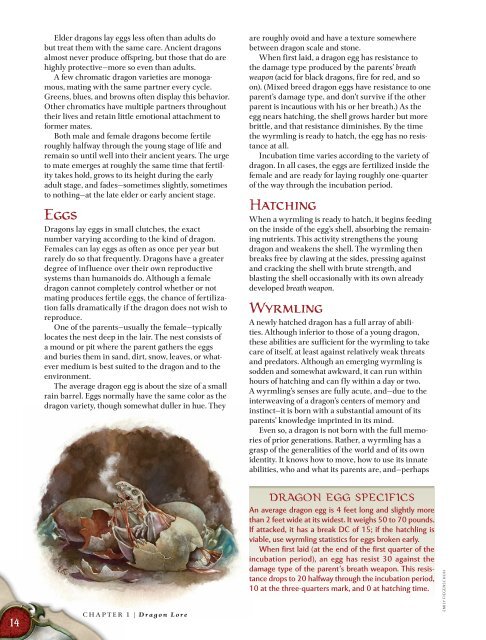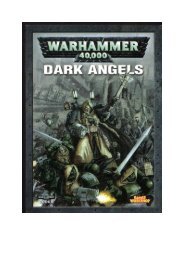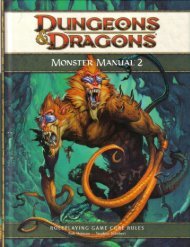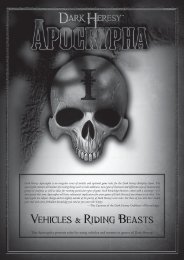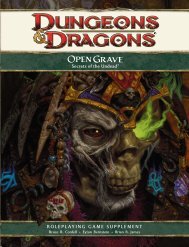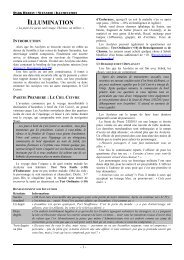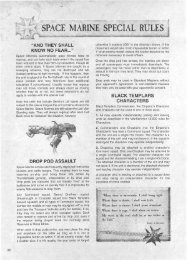Create successful ePaper yourself
Turn your PDF publications into a flip-book with our unique Google optimized e-Paper software.
Elder <strong>dragons</strong> lay eggs less often than adults dobut treat them with the same care. Ancient <strong>dragons</strong>almost never produce offspring, but those that do arehighly protective—more so even than adults.A few <strong>chromatic</strong> dragon varieties are monogamous,mating with the same partner every cycle.Greens, blues, and browns often display this behavior.Other <strong>chromatic</strong>s have multiple partners throughouttheir lives and retain little emotional attachment toformer mates.Both male and female <strong>dragons</strong> become fertileroughly halfway through the young stage of life andremain so until well into their ancient years. The urgeto mate emerges at roughly the same time that fertilitytakes hold, grows to its height during the earlyadult stage, and fades—sometimes slightly, sometimesto nothing—at the late elder or early ancient stage.EggsDragons lay eggs in small clutches, the exactnumber varying according to the kind of dragon.Females can lay eggs as often as once per year butrarely do so that frequently. Dragons have a greaterdegree of influence over their own reproductivesystems than humanoids do. Although a femaledragon cannot completely control whether or notmating produces fertile eggs, the chance of fertilizationfalls dramatically if the dragon does not wish toreproduce.One of the parents—usually the female—typicallylocates the nest deep in the lair. The nest consists ofa mound or pit where the parent gathers the eggsand buries them in sand, dirt, snow, leaves, or whatevermedium is best suited to the dragon and to theenvironment.The average dragon egg is about the size of a smallrain barrel. Eggs normally have the same color as thedragon variety, though somewhat duller in hue. Theyare roughly ovoid and have a texture somewherebetween dragon scale and stone.When first laid, a dragon egg has resistance tothe damage type produced by the parents’ breathweapon (acid for black <strong>dragons</strong>, fire for red, and soon). (Mixed breed dragon eggs have resistance to oneparent’s damage type, and don’t survive if the otherparent is incautious with his or her breath.) As theegg nears hatching, the shell grows harder but morebrittle, and that resistance diminishes. By the timethe wyrmling is ready to hatch, the egg has no resistanceat all.Incubation time varies according to the variety ofdragon. In all cases, the eggs are fertilized inside thefemale and are ready for laying roughly one-quarterof the way through the incubation period.HatchingWhen a wyrmling is ready to hatch, it begins feedingon the inside of the egg’s shell, absorbing the remainingnutrients. This activity strengthens the youngdragon and weakens the shell. The wyrmling thenbreaks free by clawing at the sides, pressing againstand cracking the shell with brute strength, andblasting the shell occasionally with its own alreadydeveloped breath weapon.WyrmlingA newly hatched dragon has a full array of abilities.Although inferior to those of a young dragon,these abilities are sufficient for the wyrmling to takecare of itself, at least against relatively weak threatsand predators. Although an emerging wyrmling issodden and somewhat awkward, it can run withinhours of hatching and can fly within a day or two.A wyrmling’s senses are fully acute, and—due to theinterweaving of a dragon’s centers of memory andinstinct—it is born with a substantial amount of itsparents’ knowledge imprinted in its mind.Even so, a dragon is not born with the full memoriesof prior generations. Rather, a wyrmling has agrasp of the generalities of the world and of its ownidentity. It knows how to move, how to use its innateabilities, who and what its parents are, and—perhaps14CHAPTER 1 | Dragon LoreDRAGON EGG SPECIFICSAn average dragon egg is 4 feet long and slightly morethan 2 feet wide at its widest. It weighs 50 to 70 pounds.If attacked, it has a break DC of 15; if the hatchling isviable, use wyrmling statistics for eggs broken early.When first laid (at the end of the first quarter of theincubation period), an egg has resist 30 against thedamage type of the parent’s breath weapon. This resistancedrops to 20 halfway through the incubation period,10 at the three-quarters mark, and 0 at hatching time.EMILY FIEGENSCHUH


